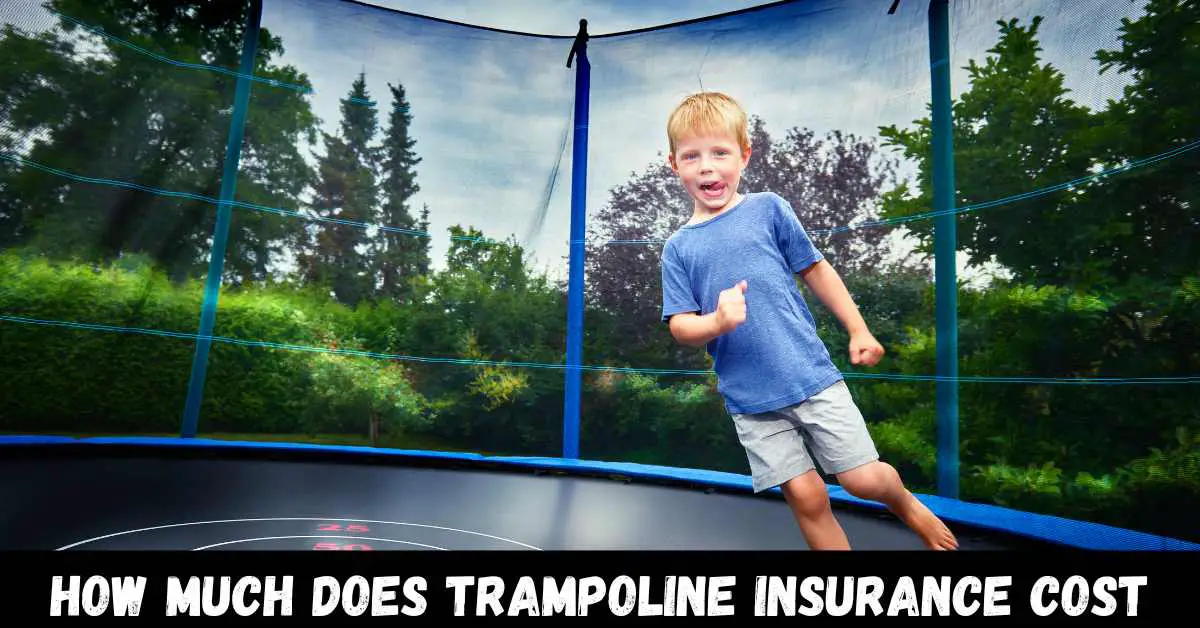Trampoline insurance is a type of liability insurance that is designed to protect homeowners who have trampolines on their property. Trampolines are a fun way for families to exercise and spend time outdoors, but they also come with a certain amount of risk.
Accidents can happen, and injuries can occur, which is why it’s essential to have the proper insurance coverage in place to protect yourself and your family.
The cost of trampoline insurance can vary based on several factors, including the size and type of trampoline, the location, and the level of coverage you need.
Many homeowners insurance policies do not cover trampoline-related accidents, so purchasing a separate insurance policy is often necessary.
In this article, we will explore the different factors that can affect the cost of trampoline insurance and give you an idea of how much you can expect to pay for this type of coverage.
By the end of this article, you will have a better understanding of the importance of trampoline insurance and how to choose the right policy for your needs.
How much does trampoline insurance cost? Trampoline insurance covers accidents and injuries related to trampoline use. Costs vary based on trampoline size, location, and coverage. Typically, it ranges from $150 to $500 annually, depending on provider and coverage.
How much does trampoline insurance cost?
The cost of trampoline insurance can vary depending on several factors, such as the type of trampoline, its location, and the insurance company’s policies. On average, the cost of trampoline insurance can range from $100 to $500 per year.
However, some insurance providers may offer lower or higher rates depending on the level of coverage selected and the specific risk factors associated with the trampoline.
It is important to shop around and obtain quotes from multiple insurance providers to find affordable trampoline insurance that meets your specific needs and requirements.
Understanding Trampoline Insurance
Trampoline insurance is a type of insurance policy that provides coverage for accidents, injuries, and property damage related to trampolines. This insurance is essential for individuals who own trampolines or use them frequently.
Trampoline insurance typically covers the following:
Medical Expenses:
This coverage pays for medical expenses associated with injuries caused by trampolines. It may include hospitalization, surgery, doctor visits, medications, and other related expenses.
Liability Coverage:
This coverage protects trampoline owners from lawsuits resulting from injuries sustained on their property. It may also provide coverage for damage to other people’s property.
Property Damage Coverage:
This coverage pays for damage caused to trampolines due to various causes such as fire, vandalism, theft, or natural disasters. It’s important to have trampoline insurance for several reasons.
For one, trampoline-related accidents and injuries are common, and medical bills can quickly add up. In some cases, injuries can result in long-term medical care or disability, leading to high medical costs and loss of income.
Trampoline owners can also be held liable for injuries sustained by others on their property, even if they were not directly involved in the accident. Without proper insurance coverage, trampoline owners could face significant financial damages or even lose their property.
There are several types of trampoline insurance policies available, and the type of coverage needed will depend on individual circumstances. Here are the most common types of trampoline insurance:
Homeowners Insurance:
Many homeowners insurance policies include trampoline coverage as part of their liability coverage. However, it’s important to check the policy’s terms and conditions to ensure that trampoline coverage is included.
Umbrella Insurance:
This type of insurance provides additional liability coverage beyond the limits of homeowners insurance. Umbrella insurance can be an excellent option for trampoline owners who want extra protection against liability claims.
Standalone Trampoline Insurance:
Some insurance companies offer standalone trampoline insurance policies that specifically cover trampoline-related accidents, injuries, and property damage. When choosing a trampoline insurance policy, it’s important to consider several factors.
These include the type of trampoline, its location, and the insurance company’s policies. For example, some insurance companies may not cover certain types of trampolines, such as in-ground trampolines or trampolines with no safety enclosure.
Additionally, the location of the trampoline may also affect insurance coverage. For example, if the trampoline is located in an area with a high risk of accidents or injuries, the insurance premiums may be higher.
To mitigate these factors and reduce insurance costs, trampoline owners can take several steps. These include installing safety enclosures, using safety pads and mats, and placing the trampoline in a safe and secure location.
By taking these precautions, trampoline owners can reduce the risk of accidents and injuries, and potentially lower their insurance premiums.
Factors That Affect Trampoline Insurance Costs
Trampoline insurance is an important consideration for trampoline owners, but the cost of insurance can vary widely depending on several factors.
Understanding the factors that can impact the cost of trampoline insurance can help trampoline owners make informed decisions when selecting insurance policies and take steps to mitigate costs.
Type of Trampoline:
Here are some of the factors that can impact the cost of trampoline insurance:

The type of trampoline can have a significant impact on insurance costs. For example, in-ground trampolines are generally considered safer than above-ground trampolines and may result in lower insurance premiums.
Similarly, trampolines with safety enclosures and padding may be considered safer than those without and may result in lower insurance premiums.
Location:
The location of the trampoline can also impact insurance costs. Trampolines located in areas with a higher risk of accidents or injuries, such as near swimming pools or in high-traffic areas, may result in higher insurance premiums.
Insurance Company Policies:
The policies of the insurance company providing the coverage can also impact insurance costs. Some insurance companies may have strict policies regarding trampolines, such as not covering certain types of trampolines or requiring additional safety measures.
These policies can result in higher insurance premiums.
Liability Coverage Limits:
The amount of liability coverage selected by the trampoline owner can also impact insurance costs. Higher liability coverage limits can result in higher insurance premiums.
Claims History:
The claims history of the trampoline owner can also impact insurance costs. Trampoline owners who have filed multiple insurance claims in the past may be considered higher risk and may face higher insurance premiums.
To mitigate these factors and reduce insurance costs, trampoline owners can take several steps.
Here are some strategies to consider:
Install Safety Features:
Installing safety features such as safety enclosures and padding can make the trampoline safer and may result in lower insurance premiums.
Choose a Safe Location:
Placing the trampoline in a safe and secure location, such as away from swimming pools and other hazards, can reduce the risk of accidents and injuries and may result in lower insurance premiums.
Compare Insurance Policies:
Shopping around and comparing insurance policies from different companies can help trampoline owners find the best coverage at the most affordable price.
Increase Deductibles:
Increasing deductibles can reduce insurance premiums, but it’s important to ensure that the deductible amount is affordable in the event of an accident or injury.
Maintain a Good Claims History:
Maintaining a good claims history by taking safety precautions and avoiding accidents can help trampoline owners avoid higher insurance premiums in the future.
In addition to these strategies, trampoline owners should also be sure to read and understand the terms and conditions of their insurance policy. Some policies may include exclusions or limitations that could impact coverage and insurance costs.
How to Find Affordable Trampoline Insurance
Trampoline insurance can be a valuable investment for trampoline owners, but it’s important to find affordable coverage that doesn’t sacrifice necessary protection. Here are some tips and advice for finding affordable trampoline insurance and ways to save money without sacrificing coverage:
Shop Around:

One of the best ways to find affordable trampoline insurance is to shop around and compare policies from different insurance companies. This can help trampoline owners find the best coverage at the most affordable price.
Bundle Policies:
Trampoline owners may be able to save money on insurance by bundling their trampoline insurance with other policies, such as homeowner’s insurance or auto insurance. Many insurance companies offer discounts for bundling policies.
Consider Liability Coverage Limits:
The amount of liability coverage selected by the trampoline owner can impact insurance costs. While it’s important to have adequate coverage, trampoline owners may be able to save money by selecting a lower liability coverage limit.
Increase Deductibles:
Increasing deductibles can reduce insurance premiums, but it’s important to ensure that the deductible amount is affordable in the event of an accident or injury.
Install Safety Features:
Installing safety features such as safety enclosures and padding can make the trampoline safer and may result in lower insurance premiums.
Choose a Safe Location:
Placing the trampoline in a safe and secure location, such as away from swimming pools and other hazards, can reduce the risk of accidents and injuries and may result in lower insurance premiums.
Maintain a Good Claims History:
Maintaining a good claims history by taking safety precautions and avoiding accidents can help trampoline owners avoid higher insurance premiums in the future.
Consider Working with an Independent Insurance Agent:
Independent insurance agents can help trampoline owners find the best coverage at the most affordable price. They work with multiple insurance companies and can provide expert advice and guidance.
Read and Understand the Terms and Conditions of the Insurance Policy:
Trampoline owners should carefully read and understand the terms and conditions of their insurance policy to ensure that they have adequate coverage and are not paying for unnecessary coverage.
It’s important to remember that while finding affordable trampoline insurance is important, it’s equally important to ensure that the policy provides adequate coverage.
Trampoline accidents can result in serious injuries and property damage, so it’s essential to have insurance coverage that protects against these risks.
Choosing the Right Trampoline Insurance Provider
Choosing the right trampoline insurance provider is crucial for ensuring that trampoline owners have the protection they need in the event of an accident or injury.
Here are some tips and advice for choosing a reliable and trustworthy trampoline insurance provider:
Check Their Reputation:

Research the insurance provider’s reputation by reading online reviews and ratings from other customers. Look for providers with positive reviews and a good reputation for customer service and claims handling.
Look for Experience:
Choose an insurance provider with experience in providing coverage for trampolines. This will ensure that they understand the risks associated with trampolines and can provide adequate coverage for those risks.
Consider Their Coverage Options:
Look for an insurance provider that offers coverage options tailored to trampolines. This will ensure that trampoline owners have the coverage they need for accidents and injuries that may occur on or around the trampoline.
Evaluate Their Financial Stability:
Check the insurance provider’s financial stability by reviewing their ratings from independent rating agencies such as A.M. Best or Standard & Poor’s. This will ensure that the provider is financially stable and can pay claims in the event of an accident.
Check Their Claims Handling Process:
Look for an insurance provider with a simple and efficient claims-handling process. This will make it easier for trampoline owners to file claims and receive compensation in the event of an accident or injury.
Consider Their Customer Service:
Choose an insurance provider with a strong customer service team that is knowledgeable and responsive. This will ensure that trampoline owners can get the help they need when they need it.
Look for Discounts:
Look for insurance providers that offer discounts for various reasons such as having a good claims history, installing safety features, or bundling policies. This will help trampoline owners save money on insurance premiums.
Understand the Policy Terms and Conditions:
Trampoline owners should carefully read and understand the terms and conditions of the insurance policy. This will ensure that they know exactly what is covered and not, and can make informed decisions about their coverage.
FAQs
Q.1 What does trampoline insurance cover?
Trampoline insurance typically provides coverage for injuries or damages that occur as a result of trampoline use, such as bodily injury to individuals or property damage. The specific coverage options may vary depending on the insurance provider and the policy selected.
Q.2 How much does trampoline insurance cost?
The cost of trampoline insurance can vary depending on several factors, including the type of trampoline, its location, the insurance provider’s policies, and the coverage options selected. It is best to obtain quotes from multiple insurance providers to determine the most cost-effective option.
Q.3 How do I file a claim for trampoline insurance?
If an accident or injury occurs on or around the trampoline, the trampoline owner should immediately report the incident to their insurance provider.
The insurance provider will provide instructions on how to file a claim, which typically involves providing details about the incident, including the date and time, the individuals involved, and any injuries or damages that occurred.
Q.4 What should I do if an accident occurs on my trampoline?
If an accident occurs on your trampoline, the first step is to ensure that anyone who is injured receives immediate medical attention if necessary.
Next, report the incident to your insurance provider and follow their instructions for filing a claim. If there is significant damage to the trampoline or other property, it may also be necessary to contact a repair service.
Q.5 How can I reduce the cost of trampoline insurance?
There are several ways to reduce the cost of trampoline insurance without sacrificing coverage. These include installing safety features such as safety nets and padding, choosing a higher deductible, bundling policies with other insurance coverage, and selecting an insurance provider that offers discounts for good claims history or other reasons.
Q.6 Do I need to have trampoline insurance?
While trampoline insurance is not typically required by law, it is strongly recommended for anyone who owns a trampoline.
Accidents and injuries can occur unexpectedly, and without insurance coverage, the trampoline owner may be held liable for any damages or injuries that occur on or around the trampoline.
Q.7 Can I add trampoline coverage to an existing insurance policy?
Many insurance providers offer trampoline coverage as an add-on to existing policies, such as homeowner’s insurance or renter’s insurance. It is important to review the specific policy to determine if trampoline coverage is included or if it can be added as an endorsement or rider.
Conclusion
In conclusion, the cost of trampoline insurance can vary depending on several factors, such as the type of trampoline, location, and insurance company policies.
There are different types of trampoline insurance available, including standalone trampoline insurance, homeowners insurance, and umbrella insurance.
Factors that affect trampoline insurance costs include liability coverage limits, claims history, and safety features. To find affordable trampoline insurance, it is important to shop around, bundle policies, increase deductibles, and maintain a good claims history.
Choosing the right trampoline insurance provider is also essential, and it is important to consider factors such as reputation, experience, coverage options, financial stability, claims handling process, and customer service.
It is also important to understand the policy terms and conditions and look for any available discounts.
By following these guidelines, you can find the right trampoline insurance that meets your specific needs and provides adequate coverage for you and your family.
After reading this complete guide about how much trampoline insurance costs, we hope you now understand it better. If you have any questions, please don’t hesitate to ask us in the comments section below.

